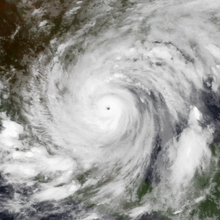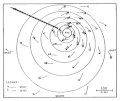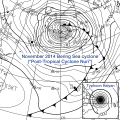Portal:Tropical cyclones
The Tropical Cyclones Portal
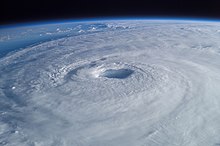
A tropical cyclone is a storm system characterized by a large low-pressure center, a closed low-level circulation and a spiral arrangement of numerous thunderstorms that produce strong winds and heavy rainfall. Tropical cyclones feed on the heat released when moist air rises, resulting in condensation of water vapor contained in the moist air. They are fueled by a different heat mechanism than other cyclonic windstorms such as Nor'easters, European windstorms and polar lows, leading to their classification as "warm core" storm systems. Most tropical cyclones originate in the doldrums, approximately ten degrees from the Equator.
The term "tropical" refers to both the geographic origin of these systems, which form almost exclusively in tropical regions of the globe, as well as to their formation in maritime tropical air masses. The term "cyclone" refers to such storms' cyclonic nature, with anticlockwise rotation in the Northern Hemisphere and clockwise rotation in the Southern Hemisphere. Depending on its location and intensity, a tropical cyclone may be referred to by names such as "hurricane", "typhoon", "tropical storm", "cyclonic storm", "tropical depression" or simply "cyclone".
Types of cyclone: 1. A "Typhoon" is a tropical cyclone located in the North-west Pacific Ocean which has the most cyclonic activity and storms occur year-round. 2. A "Hurricane" is also a tropical cyclone located at the North Atlantic Ocean or North-east Pacific Ocean which have an average storm activity and storms typically form between May 15 and November 30. 3. A "Cyclone" is a tropical cyclone that occurs in the South Pacific and Indian Oceans.
Selected named cyclone -
Hurricane Alex was the first tropical cyclone of the 2010 Atlantic hurricane season, and a rare June Atlantic hurricane. Originating from an area of disturbed weather on June 25, 2010, it slowly developed in the western Caribbean Sea and struck Belize as a strong tropical storm. After entering the Gulf of Mexico, Alex became very large and encountered conditions favorable for gradual development. Early on June 30, the cyclone attained hurricane status as it approached northeastern Mexico, the first June hurricane in the Atlantic basin since Hurricane Allison in 1995, and the storm rapidly intensified just off the coast of Tamaulipas. Alex made landfall near Soto la Marina as a Category 3 hurricane on the Saffir-Simpson Hurricane Wind Scale. Alex rapidly weakened after landfall, with the storm losing its tropical status on July 2, before fully dissipating on July 6.
Alex caused the deaths of at least 51 people along its path, and produced over $1.5 billion (2010 USD) in damage. The precursor of the hurricane produced substantial rainfall across the Greater Antilles, causing one death in the Dominican Republic. Fourteen people were killed in Central America as a result of flooding during the first landfall of Alex. In Mexico, the storm's outer rainbands killed three people in Acapulco, one person in Oaxaca, and another in Chiapas. At its final landfall, Alex caused at least fifteen deaths in Nuevo León, eight in Coahuila, six in Guanajuato, and one in both Tamaulipas and San Luis Potosí; an additional twenty persons were reported missing. (Full article...)
Selected article -

The eye is a region of mostly calm weather at the center of a tropical cyclone. The eye of a storm is a roughly circular area, typically 30–65 kilometers (19–40 miles; 16–35 nautical miles) in diameter. It is surrounded by the eyewall, a ring of towering thunderstorms where the most severe weather and highest winds of the cyclone occur. The cyclone's lowest barometric pressure occurs in the eye and can be as much as 15 percent lower than the pressure outside the storm.
In strong tropical cyclones, the eye is characterized by light winds and clear skies, surrounded on all sides by a towering, symmetric eyewall. In weaker tropical cyclones, the eye is less well defined and can be covered by the central dense overcast, an area of high, thick clouds that show up brightly on satellite imagery. Weaker or disorganized storms may also feature an eyewall that does not completely encircle the eye or have an eye that features heavy rain. In all storms, however, the eye is where the barometer reading is lowest. (Full article...)
Selected image -

Selected season -

The 1998 Atlantic hurricane season was a catastrophic and deadly Atlantic hurricane season, which had the highest number of storm-related fatalities in over 218 years and some of the costliest ever at the time. The season had above average activity, due to the dissipation of an El Niño event and transition to La Niña conditions. It officially began on June 1 and ended on November 30, dates which conventionally delimit the period during which most tropical cyclones form in the Atlantic Ocean. The season had a rather slow start, with no tropical cyclones forming in June. The first tropical cyclone, Tropical Storm Alex, developed on July 27, and the season's final storm, Hurricane Nicole, became extratropical on December 1.
Several storms made landfall or directly affected land. Hurricane Bonnie made landfall in southeastern North Carolina as a Category 2 hurricane in late August, killing five people and causing about $1 billion in damage. Hurricane Earl caused $79 million in damage and three deaths after making landfall in Florida as a Category 1 hurricane. (Full article...)
Related portals
Currently active tropical cyclones

Italicized basins are unofficial.
- North Atlantic (2025)
- No active systems
- East and Central Pacific (2025)
- No active systems
- West Pacific (2025)
- No active systems
- North Indian Ocean (2025)
- No active systems
- Mediterranean (2024–25)
- No active systems
- South-West Indian Ocean (2024–25)
- No active systems
- South Pacific (2024–25)
- No active systems
- South Atlantic (2024–25)
- No active systems
Last updated: 07:55, 21 January 2025 (UTC)
Tropical cyclone anniversaries

January 22
- 1997 - Cyclone Pancho-Helinda reached its peak with a central pressure of 925 hPa (mbar) in the eastern Indian Ocean.
- 2013 - Cyclone Oswald (flooding pictured) weakened into a tropical low, but its remnants brought torrential rainfall of over 1,000 mm (39 in) to eastern Australia. The rains caused widespread flooding that left US$2.28 billion in damage and six deaths.

January 23
- 2005 - Cyclone Ernest (pictured) struck southwestern Madagascar, killing 78 people.
- 2020 - Subtropical Storm Kurumí develops off the coast of southern Brazil, with associated floods and mudslides killing 70 people.
- 2021 - Cyclone Eloise moved ashore Mozambique, and across southeastern Africa the storm killed 27 people.

January 24
- 1974 - Cyclone Wanda hit Queensland, bringing heavy rainfall and floods to the Brisbane area. Wanda killed 16 people and caused over $200 million of damage.
- 1997 - Cyclone Gretelle (pictured) struck southeastern Madagascar with 220 km/h (140 mph) winds, which produced floods 16 m (52 ft) deep in some places. About 80,000 people were left homeless, and many were isolated after roads were damaged. The storm killed 152 people and left US$50 million in damage to the country.
- 2012 - Cyclone Funso reached peak intensity in the Mozambique Channel. Its large size caused 40 deaths, including 15 related to a shipwreck.
Did you know…
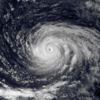



- …that the Joint Typhoon Warning Center considers that Typhoon Vera (pictured) of 1986 is actually two distinct systems, formed from two separated low-level circulations?
- …that Cyclone Freddy (track pictured) in 2023 was the longest-lasting tropical cyclone recorded?
- …that the typhoons of 2024—Yinxing, Toraji, Usagi, and Man-yi (pictured)—made history as the first recorded instance since 1951 of four tropical cyclones coexisting in November?
- …that Hurricane Otis (pictured) in 2023 was the first Pacific hurricane to make landfall at Category 5 intensity and surpassed Hurricane Patricia as the strongest landfalling Pacific hurricane on record?
General images -
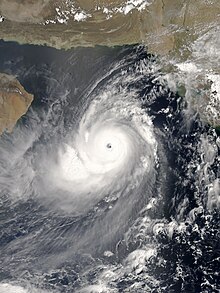
The Arabian Peninsula is a peninsula between the Red Sea, the Arabian Sea, and the Persian Gulf. There are 64 known tropical cyclones that affected the peninsula, primarily Yemen and Oman. For convenience, storms are included that affected the Yemeni island of Socotra. Most of the tropical cyclones originated in the Arabian Sea, the portion of the Indian Ocean north of the equator and west of India. The remainder formed in the Bay of Bengal off India's east coast. Collectively, the 64 storms have caused at least US$8.3 billion in damage and 1,693 deaths. The strongest and most damaging cyclone was Cyclone Gonu, which caused US$4 billion in damage and 50 fatalities when it struck Oman in 2007. Tropical cyclone damage in the Arabian Peninsula is chiefly due to flooding. (Full article...)
Topics
Subcategories
Related WikiProjects
WikiProject Tropical cyclones is the central point of coordination for Wikipedia's coverage of tropical cyclones. Feel free to help!
WikiProject Weather is the main center point of coordination for Wikipedia's coverage of meteorology in general, and the parent project of WikiProject Tropical cyclones. Three other branches of WikiProject Weather in particular share significant overlaps with WikiProject Tropical cyclones:
- The Non-tropical storms task force coordinates most of Wikipedia's coverage on extratropical cyclones, which tropical cyclones often transition into near the end of their lifespan.
- The Floods task force takes on the scope of flooding events all over the world, with rainfall from tropical cyclones a significant factor in many of them.
- WikiProject Severe weather documents the effects of extreme weather such as tornadoes, which landfalling tropical cyclones can produce.
Things you can do
 |
Here are some tasks awaiting attention:
|
Wikimedia
The following Wikimedia Foundation sister projects provide more on this subject:
-
Commons
Free media repository -
Wikibooks
Free textbooks and manuals -
Wikidata
Free knowledge base -
Wikinews
Free-content news -
Wikiquote
Collection of quotations -
Wikisource
Free-content library -
Wikiversity
Free learning tools -
Wikivoyage
Free travel guide -
Wiktionary
Dictionary and thesaurus

